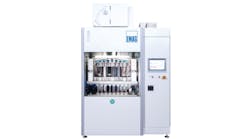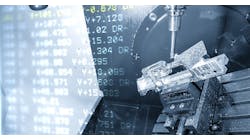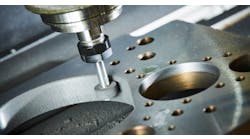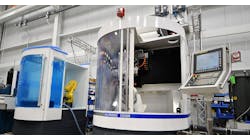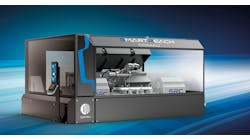Guest editorial by Jeff Day, ([email protected]) waterjet product manager at Bystronic Inc.
Increasing the number of cutting heads on a waterjet has the most dramatic effect on increasing a shop’s number of parts per day. Automatic head spacing on two-head systems is critical to getting the maximum material use out of nesting with two heads. Automatic head spacing should allow one head to automatically be turned off so that one head can be run on small strips of materials. Without such a capability, large amounts of raw material can be wasted.
In addition to cutting with multiple heads, material handling offers huge opportunities to reduce downtime on a waterjet. In many shops, operators spend large amounts of time unloading and loading machines.
Automatic shuttle tables provide the means for optimizing a machine’s cutting time. Higher machine use and the elimination of machine idle time result from the fact that machines keep working while raw material is loaded and finished parts unloaded. And since a shuttle table transports completely out of the cutting area, a sheet loader can be added without interference with the cutting bridge.
Machines with large cutting areas also help optimize cutting time. Shops can cut in one area while loading and unloading in another. But to safely use a machine in this way, it must be equipped with appropriate guarding, software and safety systems to ensure the machine movements cannot injure anyone loading/unloading while the cutting bridge is in operation.
Large-table machines require a higher investment and more floorspace, but purchasing one large-table machine can be less expensive than buying two separate machines. And they allow shops to process large individual parts.
Height sensing can also reduce part cost in that the closer a shop can cut to the surface of the material, the faster it can cut since less of the jet’s energy is lost. The optimal distance between nozzle and material surface is between 0.040 in. and 0.060 in., a distance that allows faster cutting at any given part quality desired. Cutting closer to the surface yields a better part quality because there will be less rounding of the top edge of the part.
Trying to control height manually means operators would have to spend 100 percent of the time standing at the machine. Plus, collision detection/protection in conjunction with height sensing reduces the likelihood of breaking abrasive nozzles on tipped parts, further reducing consumable part costs.
Many shops are now considering the “soft costs” related to operating machine tools. A good programming software system can help significantly reduce engineering labor costs, optimize material use, shorten turnaround time from order to finished part, and provide the capability to automatically interface to other operations such as bending if required. If programming time can be reduced, so too can cycle times, and material use can be improved.
Common-line cutting is one example. For parts that have long straight edges, common-line cutting can greatly reduce cycle time and material cost. A 24-in.-long straight edge on two adjacent pieces of 1-in-thick steel that only need to be cut once with a common-line cut can save six minutes of cutting and abrasive consumption. At 0.9 lb per minute of abrasive, this saves 5.9 lb of abrasive on only on common-line cut and eliminates the material “web” required with two individual cuts.

